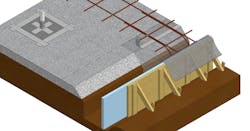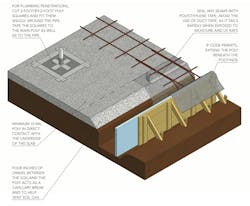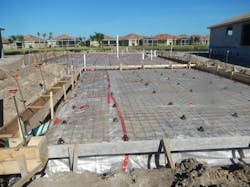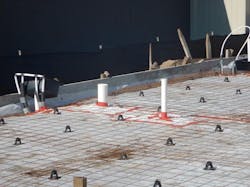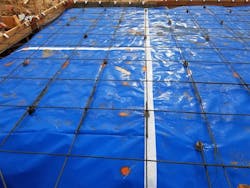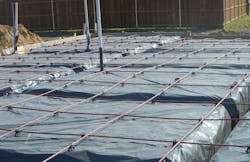Concrete is hygroscopic, which means a concrete slab foundation will absorb moisture from the earth and transfer it to the basement, crawlspace, or living area where it can cause an array of problems, including finished flooring failures, mold growth, and potential health problems for your homeowners.
A properly selected and installed polyethylene vapor barrier between the slab and the soil effectively keeps ground moisture away from the concrete to mitigate these issues. Anything less (or nothing at all) is a recipe for myriad problems down the road.
Here are some best practices for vapor barrier installation, as well as some errors and omissions I see on jobsites all over the country.
Vapor Barrier Installation Basics
The most obvious best practice is to install a sub-slab vapor barrier in the first place. I recommend a minimum 10-mil-thick polyethylene material, even if your local building code allows a 6-mil, as it lasts longer and is less prone to punctures.
Some builders in desert climates ignore this advice, figuring that they don’t have to worry about under-slab moisture. But whether moisture will be a problem depends in part on the finished floor coverings. For instance, if you apply vinyl flooring directly to the slab, even occasional moisture in markets such as Phoenix can be enough to accelerate the potential for failure between the vinyl and the concrete.
RELATED
- Purchasing: the Harsh Realities of Buying Concrete
- Concrete Solutions for Lurking Moisture
- Proper Backfilling and Grading for a Dry Foundation
- How to Avoid Cracks in Post-Tensioned Concrete Slab Foundations
A poly vapor barrier also helps keep soil gas (such as radon, among others) out of the house. As building scientist Joe Lstiburek noted in 2002, “We are building our houses on more sites that were previously treated with chemicals of all sorts, from pesticides to petroleum to PCBs.” Things have only gotten worse in that regard since.
To further mitigate soil gas intrusion, install the vapor barrier over a 4-inch bed of level, compacted gravel before you pour the slab. If you also install a vent stack for soil gas, the gravel will provide a base layer through which air can move laterally toward the stack. In areas where soil gas isn’t a problem, the gravel will still serve as a capillary break to keep moisture at bay.
How Concrete Curing Issues Affect Vapor Barriers
For an under-slab vapor barrier to be most effective, it should be in direct contact with the underside of the slab. In this instance, however, the freshly poured concrete can only dry upward; in hot/dry climates, the upper few inches of the slab tend to dry and shrink more quickly than the lower few inches, which can cause the edges of the slab to curl and lose connection with the vapor barrier.
Some contractors put a layer of sand between the poly and the concrete to give the slab a chance to dry in both directions; however, moisture inevitably gets trapped in the sand, and once the concrete dries, that moisture will begin transferring hygroscopically to the slab. Fully drying a sub-slab layer of sand can take months or even years.
Rather than sand, I recommend using a curing agent for the concrete. It will prevent edge curl by slowing the curing rate of the slab enough that all the moisture has time to evaporate through the upper surface.
Other best practices include extending the poly under the footings where permitted by code, as well as sealing all penetrations, as detailed in the illustration below.
Access a PDF of this article in Pro Builder's October 2019 digital edition
MORE INFO: Do Concrete Slabs Really Need Welded Wire Mesh?
Concrete vapor barriers
Below are some examples of proper under-slab vapor barrier installations (all photos courtesy IBACOS).
Graham Davis drives quality and performance in home building as a building performance specialist of the PERFORM Builder Solutions team at IBACOS.
RELATED
From Pro Builder's sister site ProTradeCraft.com:
